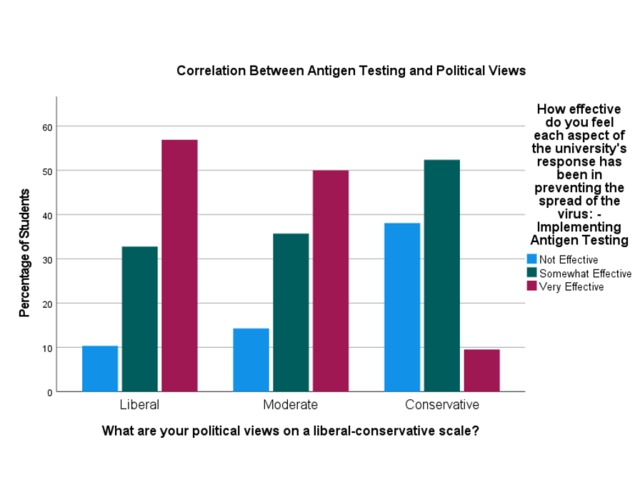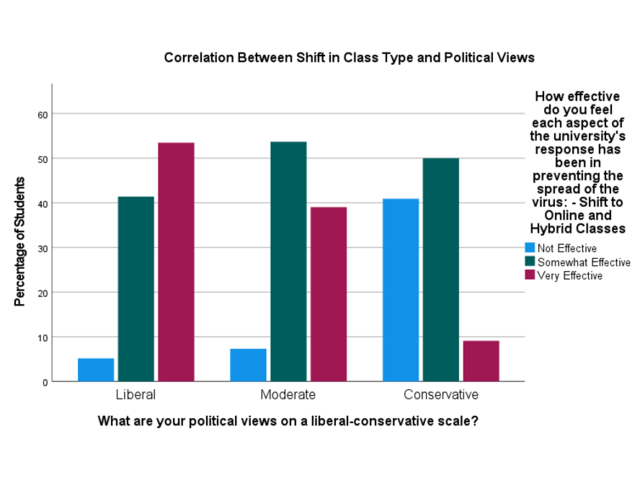by Lexi Mulholland ('22) and Peter Hart-Brinson
Nearly one year after the beginning of the COVID-19 pandemic, the fifth wave of the Eau Claire Longitudinal Student Survey (ECLSS) was completed by UWEC students. With the campus back open, the Spring 2021 semester was a prime era to study exactly how the pandemic has impacted the lives of these students, along with their opinions of the university’s COVID policies.
How the Pandemic Affected Undergraduates
The first question students in the Sociological Research Methods (SOC 332) class asked was, “How has the pandemic affected each aspect of your life?” The question asked about both students’ academic and personal lives: education, major, social life, finances, work, extra-curriculars, grades, family, relationships/dating, and mental health. The results show that every single aspect of students’ lives was more negatively than positively affected due to the pandemic.

The chart at right displays the percentage of students who chose said each aspect of their life was affected negatively or very negatively. The aspects where over half of the students chose negatively or very negatively affected include education (82%), social life (81%), finances (58%), work (57%), extra-curriculars (68%), and mental health (78%). The life aspect that was least negatively affected was relationships/dating; however, nearly 1/3 of the sample said that was affected negatively as well. These results show that, for the most part, the COVID-19 pandemic was a net negative, not just for the college and academic lives of students, but for their personal lives as well.
Were All Students Equally Affected?
After establishing that the pandemic was a net negative for students, a comparison between these effects and the demographic characteristics of undergraduates was done. We hypothesized that students from certain backgrounds were more likely to be negatively impacted by the pandemic than others. However, the results did not support this hypothesis. There were very few statistically significant correlations that showed one type of student being consistently impacted more negatively than others. Take gender, for instance. Looking at mental health, the results were extremely statistically significant at p < 0.001, with women being the most negatively impacted, followed by non-binary individuals, and then men. However, looking at a different aspect such as education, men were the most negatively impacted. Race also seemed a likely factor in students’ experiences of the pandemic; we hypothesized that students of color would be more negatively impacted, but it was actually white students who said they were more negatively impacted regarding social life, extra-curriculars, and mental health. Although the hypothesis that demographic characteristics were correlated with a stronger negative impact from the pandemic proved to be incorrect, the results did show how virtually everyone from every background was negatively affected by the COVID-19 pandemic.
COVID-19 and Politics

The one variable that did consistently shape people’s views of the pandemic was politics. It wasn’t associated with how negatively students were affected, but it did shape how students felt about the regulations the university implemented during the pandemic. For the most part, UWEC students lean moderate to liberal, with 32% identifying as moderate, 28% identifying as liberal, 16% identifying as very liberal, 14% identifying as conservative, and 3% identifying as very conservative. We found many differences in how these students answered different aspects of the question, “How effective do you feel each aspect of the university's response has been in preventing the spread of the virus?”

These three charts show the comparison between students’ political views and how effective they felt the university’s implementation of the Mask Mandate, Antigen Testing, and Switching to Online/Hybrid Courses. The results for each of these were very statistically significant (p. < 0.001 for all). For the mask mandate, liberals were most likely to choose very effective, at 64%, moderates were equally likely to choose somewhat effective or very effective, at 45% for both categories, and conservatives were most likely to choose not effective, at 50%. Similar results were found for the antigen testing and the shift to online/hybrid courses, with liberals being most likely to choose very effective and conservatives either choosing somewhat or not effective most often.

Students also differed in how comfortable students felt being on campus during the pandemic and whether or not it was a good idea to be on campus during the pandemic. For instance, when asked, “How comfortable did you feel coming to campus last semester (Fall)?”, conservatives were more likely than liberals to say “very comfortable” (55%). Notably, no conservatives chose very uncomfortable or somewhat uncomfortable for this question. While students of all political views agreed with the university’s decision to hold in-person classes during the pandemic, conservatives expressed the strongest approval. These results show that liberals were more likely to believe in the effectiveness of the university’s COVID-19 regulations than conservatives were but that conservatives were more comfortable being on campus during the pandemic.
Conclusion
Overall, the pandemic had a negative impact on all kinds of UWEC students. The consequences of this pandemic may be long-lasting, and our political divisions threaten to make them worse if they prevent us from coming together to work through one of the worst societal upheavals of our era.
